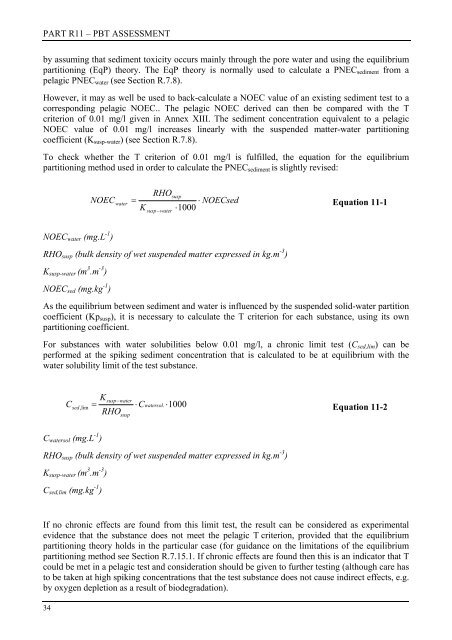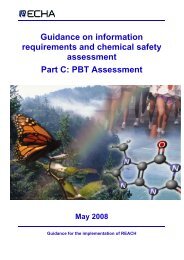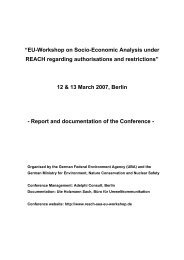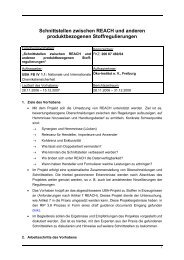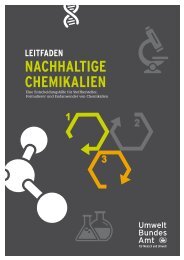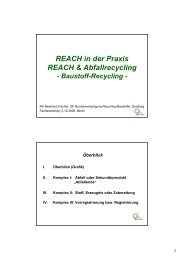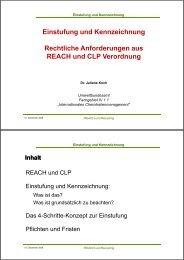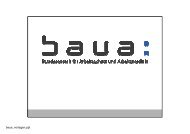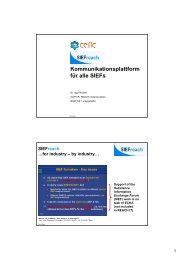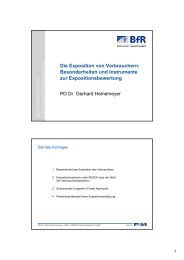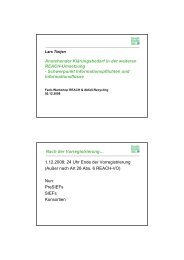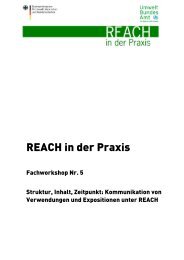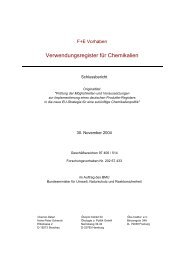PBT Assessment - REACh
PBT Assessment - REACh
PBT Assessment - REACh
You also want an ePaper? Increase the reach of your titles
YUMPU automatically turns print PDFs into web optimized ePapers that Google loves.
PART R11 – <strong>PBT</strong> ASSESSMENT<br />
by assuming that sediment toxicity occurs mainly through the pore water and using the equilibrium<br />
partitioning (EqP) theory. The EqP theory is normally used to calculate a PNECsediment from a<br />
pelagic PNECwater (see Section R.7.8).<br />
However, it may as well be used to back-calculate a NOEC value of an existing sediment test to a<br />
corresponding pelagic NOEC.. The pelagic NOEC derived can then be compared with the T<br />
criterion of 0.01 mg/l given in Annex XIII. The sediment concentration equivalent to a pelagic<br />
NOEC value of 0.01 mg/l increases linearly with the suspended matter-water partitioning<br />
coefficient (Ksusp-water) (see Section R.7.8).<br />
To check whether the T criterion of 0.01 mg/l is fulfilled, the equation for the equilibrium<br />
partitioning method used in order to calculate the PNECsediment is slightly revised:<br />
NOECwater (mg.L -1 )<br />
RHOsusp (bulk density of wet suspended matter expressed in kg.m -3 )<br />
Ksusp-water (m 3 .m -3 )<br />
NOECsed (mg.kg -1 )<br />
34<br />
Equation 11-1<br />
As the equilibrium between sediment and water is influenced by the suspended solid-water partition<br />
coefficient (Kpsusp), it is necessary to calculate the T criterion for each substance, using its own<br />
partitioning coefficient.<br />
For substances with water solubilities below 0.01 mg/l, a chronic limit test (Csed,lim) can be<br />
performed at the spiking sediment concentration that is calculated to be at equilibrium with the<br />
water solubility limit of the test substance.<br />
C<br />
sed,<br />
lim<br />
Cwatersol (mg.L -1 )<br />
RHOsusp (bulk density of wet suspended matter expressed in kg.m -3 )<br />
Ksusp-water (m 3 .m -3 )<br />
Csed,lim (mg.kg -1 )<br />
NOEC<br />
water<br />
Ksusp−<br />
=<br />
RHO<br />
water<br />
susp<br />
=<br />
K<br />
⋅C<br />
RHOsusp<br />
⋅ NOECsed<br />
⋅1000<br />
susp−water<br />
watersol.<br />
⋅1000<br />
Equation 11-2<br />
If no chronic effects are found from this limit test, the result can be considered as experimental<br />
evidence that the substance does not meet the pelagic T criterion, provided that the equilibrium<br />
partitioning theory holds in the particular case (for guidance on the limitations of the equilibrium<br />
partitioning method see Section R.7.15.1. If chronic effects are found then this is an indicator that T<br />
could be met in a pelagic test and consideration should be given to further testing (although care has<br />
to be taken at high spiking concentrations that the test substance does not cause indirect effects, e.g.<br />
by oxygen depletion as a result of biodegradation).


